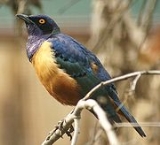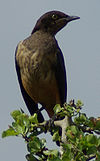
Hildebrandt's Starling
Encyclopedia
Hildebrandt's Starling (Lamprotornis hildebrandti) is a species of starling
in the family Sturnidae. It forms a superspecies
with and has previously been included in the same species as Shelley's Starling
, which is a migratory species ranging from Ethiopia
and Somalia
to Kenya
. Both of these species have also been combined into a superspecies with the Chestnut-bellied Starling
of West Africa. It was originally placed in the now defunct genus Notauges. The species is named for Johannes Hildebrandt
, a German collector who was the first European to obtain specimens.
and Tanzania
, where it occupies open country between 500 to 2200 m (1,640.4 to 7,217.8 ft). Its habitat is open woodland and open thornbrush country. The species is often recorded as being uncommon, but it varies from being fairly common to fairly uncommon. It is not considered threatened by the IUCN, and is listed as least concern
. Its habitat is not threatened and it occurs in a number of protected areas.
plumage
on its upper body and upper surfaces. As in its relatives, this iridescence is derived from the interference of reflected light from regimented microscopic feather structures and not from pigments. The head is blue as are most of the upperparts, the wings are bronze-green with blue primaries
, the throat and upper breast are glossy purple, and the tail is glossy blue-green. The middle breast and upper belly are orange-buff and the lower belly is rufous. The iris is orange-red, and the bill and legs are black. Male and female adults are identical in external appearance. The juveniles are quite different, with charcoal grey upperparts and chestnut brown lowerparts.
The species makes a number of calls and songs. Its song s a slow low "ch-rak ch-rak chee-chee-wee chee-wee rak rak rak". It also has an alarm call, "chu-ee" and has a contact call, "chule".
 The diet of Hildebrandt's Starling is a combination of insects and fruit, with insects apparently being the more important constituent. It has been observed feeding on beetles and grasshoppers, as well as hawking for flying termites. Seeds from fruit have also been found in the stomachs of some birds, including those from Carissa edulis, Euclea
The diet of Hildebrandt's Starling is a combination of insects and fruit, with insects apparently being the more important constituent. It has been observed feeding on beetles and grasshoppers, as well as hawking for flying termites. Seeds from fruit have also been found in the stomachs of some birds, including those from Carissa edulis, Euclea
, Rhus and Apodytes dimidiata
. It usually feeds on the ground, in pairs and small flocks, and will readily follow large mammals and catch prey flushed by their movement. It also joins mixed flocks of other starlings.
Hildebrandt's Starling is a seasonal nester, with birds nesting in March to May and October to December, although in some parts of Kenya the season is May to July. It usually breeds in pairs but cooperative breeding has been recorded on occasion. It is a cavity nester, usually building its nest of plant fibres in an abandoned woodpecker
nest in a tree. Where this is not possible it has been recorded nesting in a hole in a fence post, lamppost or telegraph pole. It competes with the Greater Blue-eared Starling
for nesting sites. Little is known about its nesting behaviour, although it is known that the clutch
is three to four eggs. Both the parents are involved in feeding the young. The nests of this species are parasitised
by the Great Spotted Cuckoo
.
Starling
Starlings are small to medium-sized passerine birds in the family Sturnidae. The name "Sturnidae" comes from the Latin word for starling, sturnus. Many Asian species, particularly the larger ones, are called mynas, and many African species are known as glossy starlings because of their iridescent...
in the family Sturnidae. It forms a superspecies
Superspecies
A superspecies is a group of at least two more or less distinctive species with approximately parapatric distributions. Not all species complexes, whether cryptices or ring species are superspecies, and vice versa, but many are...
with and has previously been included in the same species as Shelley's Starling
Shelley's Starling
The Shelley's Starling is a species of starling in the Sturnidae family.It is found in Ethiopia, Kenya, Somalia, Sudan, and Tanzania.-References:* BirdLife International 2004. . Downloaded on 24 July 2007....
, which is a migratory species ranging from Ethiopia
Ethiopia
Ethiopia , officially known as the Federal Democratic Republic of Ethiopia, is a country located in the Horn of Africa. It is the second-most populous nation in Africa, with over 82 million inhabitants, and the tenth-largest by area, occupying 1,100,000 km2...
and Somalia
Somalia
Somalia , officially the Somali Republic and formerly known as the Somali Democratic Republic under Socialist rule, is a country located in the Horn of Africa. Since the outbreak of the Somali Civil War in 1991 there has been no central government control over most of the country's territory...
to Kenya
Kenya
Kenya , officially known as the Republic of Kenya, is a country in East Africa that lies on the equator, with the Indian Ocean to its south-east...
. Both of these species have also been combined into a superspecies with the Chestnut-bellied Starling
Chestnut-bellied Starling
The Chestnut-bellied Starling is a species of starling in the Sturnidae family.It is found in Burkina Faso, Cameroon, Chad, Ivory Coast, Eritrea, Ethiopia, Gambia, Ghana, Guinea, Guinea-Bissau, Mali, Mauritania, Niger, Nigeria, Senegal, Sudan, and Togo.-References:* BirdLife International 2004. ....
of West Africa. It was originally placed in the now defunct genus Notauges. The species is named for Johannes Hildebrandt
Johannes Hildebrandt
Johannes Maria Hildebrandt, born 13 or 19 March 1847, died 29 May 1881, was a German explorer and collector. He was born in Düsseldorf to a family of painters. Originally a machine maker, he lost an eye after an accident and became a gardener, eventually starting work in 1869 for the Berlin...
, a German collector who was the first European to obtain specimens.
Distribution and habitat
Hildebrandt's Starling is found in KenyaKenya
Kenya , officially known as the Republic of Kenya, is a country in East Africa that lies on the equator, with the Indian Ocean to its south-east...
and Tanzania
Tanzania
The United Republic of Tanzania is a country in East Africa bordered by Kenya and Uganda to the north, Rwanda, Burundi, and the Democratic Republic of the Congo to the west, and Zambia, Malawi, and Mozambique to the south. The country's eastern borders lie on the Indian Ocean.Tanzania is a state...
, where it occupies open country between 500 to 2200 m (1,640.4 to 7,217.8 ft). Its habitat is open woodland and open thornbrush country. The species is often recorded as being uncommon, but it varies from being fairly common to fairly uncommon. It is not considered threatened by the IUCN, and is listed as least concern
Least Concern
Least Concern is an IUCN category assigned to extant taxon or lower taxa which have been evaluated but do not qualify for any other category. As such they do not qualify as threatened, Near Threatened, or Conservation Dependent...
. Its habitat is not threatened and it occurs in a number of protected areas.
Description
Hildebrandt's Starling is 18 cm (7.1 in) in length and weighs 50 to 69 g (1.8 to 2.4 oz). The adult has bright iridescentIridescence
Iridescence is generally known as the property of certain surfaces which appear to change color as the angle of view or the angle of illumination changes...
plumage
Plumage
Plumage refers both to the layer of feathers that cover a bird and the pattern, colour, and arrangement of those feathers. The pattern and colours of plumage vary between species and subspecies and can also vary between different age classes, sexes, and season. Within species there can also be a...
on its upper body and upper surfaces. As in its relatives, this iridescence is derived from the interference of reflected light from regimented microscopic feather structures and not from pigments. The head is blue as are most of the upperparts, the wings are bronze-green with blue primaries
Flight feather
Flight feathers are the long, stiff, asymmetrically shaped, but symmetrically paired feathers on the wings or tail of a bird; those on the wings are called remiges while those on the tail are called rectrices . Their primary function is to aid in the generation of both thrust and lift, thereby...
, the throat and upper breast are glossy purple, and the tail is glossy blue-green. The middle breast and upper belly are orange-buff and the lower belly is rufous. The iris is orange-red, and the bill and legs are black. Male and female adults are identical in external appearance. The juveniles are quite different, with charcoal grey upperparts and chestnut brown lowerparts.
The species makes a number of calls and songs. Its song s a slow low "ch-rak ch-rak chee-chee-wee chee-wee rak rak rak". It also has an alarm call, "chu-ee" and has a contact call, "chule".
Behaviour

Euclea
Euclea is a genus of flowering plants, belonging to family Ebenaceae, the ebony family. The genus includes twenty species of evergreen trees and shrubs, native to Africa, the Comoro Islands, and Arabia. Several species are used for timber, producing a hard, dark heartwood timber similar to...
, Rhus and Apodytes dimidiata
Apodytes dimidiata
Apodytes dimidiata is a bushy tree, with white fragrant flowers and small, dark red berries. It is usually about 5 m tall , and it is indigenous to Southern Africa.The taxonomical family placement for this and other Apodytes is currently under debate...
. It usually feeds on the ground, in pairs and small flocks, and will readily follow large mammals and catch prey flushed by their movement. It also joins mixed flocks of other starlings.
Hildebrandt's Starling is a seasonal nester, with birds nesting in March to May and October to December, although in some parts of Kenya the season is May to July. It usually breeds in pairs but cooperative breeding has been recorded on occasion. It is a cavity nester, usually building its nest of plant fibres in an abandoned woodpecker
Woodpecker
Woodpeckers are near passerine birds of the order Piciformes. They are one subfamily in the family Picidae, which also includes the piculets and wrynecks. They are found worldwide and include about 180 species....
nest in a tree. Where this is not possible it has been recorded nesting in a hole in a fence post, lamppost or telegraph pole. It competes with the Greater Blue-eared Starling
Greater Blue-eared Glossy-starling
The Greater Blue-eared Glossy-starling or Greater Blue-eared Starling is a bird that breeds from Senegal east to Ethiopia and south through eastern Africa to northeastern South Africa and Angola...
for nesting sites. Little is known about its nesting behaviour, although it is known that the clutch
Clutch (eggs)
A clutch of eggs refers to all the eggs produced by birds or reptiles, often at a single time, particularly those laid in a nest.In birds, destruction of a clutch by predators, , results in double-clutching...
is three to four eggs. Both the parents are involved in feeding the young. The nests of this species are parasitised
Brood parasite
Brood parasites are organisms that use the strategy of brood parasitism, a kind of kleptoparasitism found among birds, fish or insects, involving the manipulation and use of host individuals either of the same or different species to raise the young of the brood-parasite...
by the Great Spotted Cuckoo
Great Spotted Cuckoo
The Great Spotted Cuckoo is a member of the cuckoo order of birds, the Cuculiformes, which also includes the roadrunners, the anis and the coucals....
.

